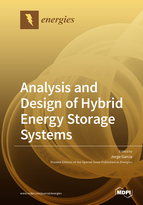Analysis and Design of Hybrid Energy Storage Systems
A special issue of Energies (ISSN 1996-1073). This special issue belongs to the section "F: Electrical Engineering".
Deadline for manuscript submissions: closed (30 April 2019) | Viewed by 36818
Special Issue Editor
Interests: power electronic converter topologies; control schemes and modeling; integration of power stages; design of magnetic components; gate drivers; energy storage applications; industrial applications
Special Issue Information
Dear Colleagues,
The most important environmental challenge today's society is facing is to reduce the effects of CO2 emissions and global warming. Such an ambitious challenge can only be achieved through a holistic approach, capable of tackling the problem from a multidisciplinary point of view.
One of the core technologies called to play a critical role in this approach is the use of energy storage systems. These systems enable, among other things, the balancing of the stochastic behavior of Renewable Sources and Distributed Generation in modern Energy Systems; the efficient supply of industrial and consumer loads; the development of efficient and clean transport; and the development of Nearly-Zero Energy Buildings (nZEB) and intelligent cities.
Hybrid Energy Storage Systems (HESS) consist of two (or more) storage devices with complementary key characteristics, that are able to behave jointly with better performance than any of the technologies considered individually. Recent developments in storage device technologies, interface systems, control and monitoring techniques, or visualization and information technologies have driven the implementation of HESS in many industrial, commercial and domestic applications.
This Special Issue focuses on the analysis, design and implementation of hybrid energy storage systems across a broad spectrum, encompassing different storage technologies (including electrochemical, capacitive, mechanical or mechanical storage devices), engineering branches (power electronics and control strategies; energy engineering; energy engineering; chemistry; modelling, simulation and emulation techniques; data analysis and algorithms; social and economic analysis; intelligent and Internet-of-Things (IoT) systems; and so on.), applications (energy systems, renewable energy generation, industrial applications, transportation, Uninterruptible Power Supplies (UPS) and critical load supply, etc.) and evaluation and performance (size and weight benefits, efficiency and power loss, economic analysis, environmental costs, etc.).
Prof. Dr. Jorge Garcia
Guest Editor
Manuscript Submission Information
Manuscripts should be submitted online at www.mdpi.com by registering and logging in to this website. Once you are registered, click here to go to the submission form. Manuscripts can be submitted until the deadline. All submissions that pass pre-check are peer-reviewed. Accepted papers will be published continuously in the journal (as soon as accepted) and will be listed together on the special issue website. Research articles, review articles as well as short communications are invited. For planned papers, a title and short abstract (about 100 words) can be sent to the Editorial Office for announcement on this website.
Submitted manuscripts should not have been published previously, nor be under consideration for publication elsewhere (except conference proceedings papers). All manuscripts are thoroughly refereed through a single-blind peer-review process. A guide for authors and other relevant information for submission of manuscripts is available on the Instructions for Authors page. Energies is an international peer-reviewed open access semimonthly journal published by MDPI.
Please visit the Instructions for Authors page before submitting a manuscript. The Article Processing Charge (APC) for publication in this open access journal is 2600 CHF (Swiss Francs). Submitted papers should be well formatted and use good English. Authors may use MDPI's English editing service prior to publication or during author revisions.
Keywords
- hybrid energy storage
- storage technologies
- power management
- renewable energy integration
- electric transportation
- power quality
- smart energy management






